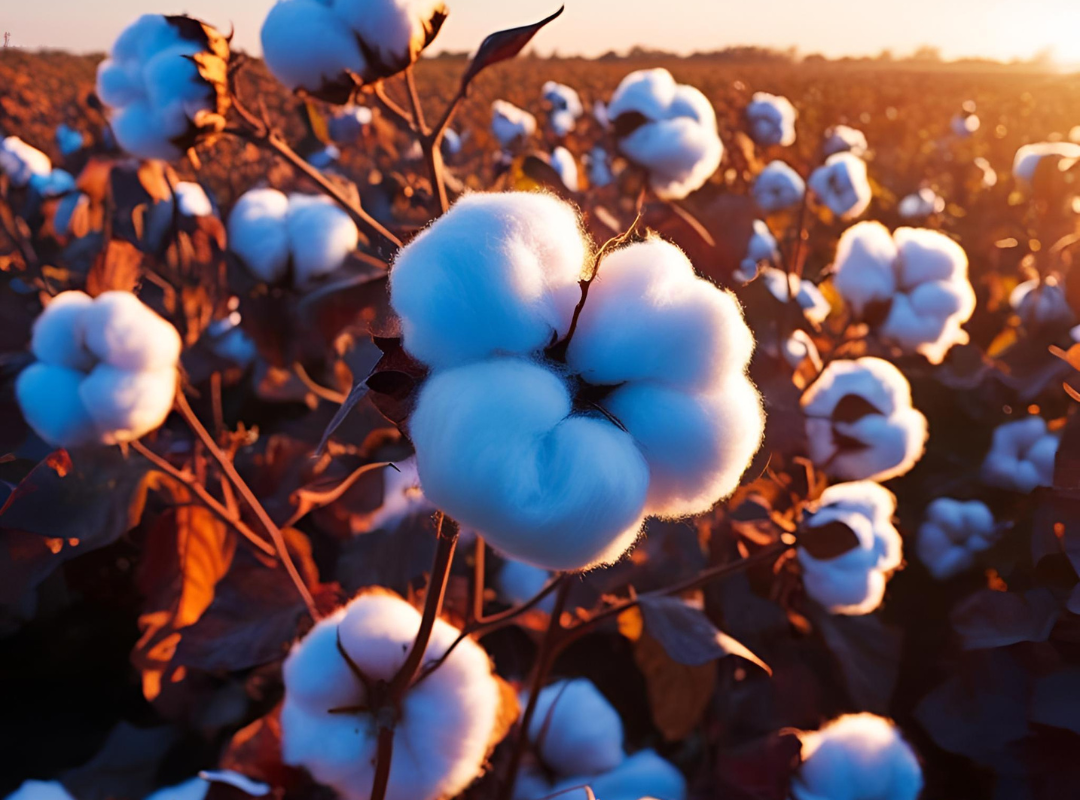This lesson is part of the From Genes to Jeans II series which was written to encourage students to hone basic genetic concepts and skills through defined vocabulary, and provided explanations all the while applying the terms to agricultural concepts used in the industry. Other related lessons and activities include:
Students should have some prior knowledge of Gregor Mendel and inheritance but it will be helpful to review the key vocabulary as you begin the lesson.
Punnett squares are one tool that scientists, farmers, and ranchers use to predict the outcome of potential crossings of two parents. It is important for students to understand that genetics are very complex and that the Punnett squares in this activity are simplified in order to teach the foundational concepts of inheritance.
Cotton is used as an example in this lesson. Cotton is grown in many states throughout the U.S. including California.
Cotton is the nation’s fifth largest crop. Most of the cotton crop goes into clothing apparel and material for home furnishings. Cottonseeds and cottonseed meal are byproducts of cotton production which are used as feed for cattle and poultry. Cottonseed oil is used in salad dressing, margarine and other oils. United States paper money is made of 75% cotton.
The cotton plant grows wild in some places of the world and has been farmed for centuries. Shreds of cotton cloth have been found that date back at least seven thousand years. Wild cotton can be found in shades of green and brown, as well as white. Most commercial cotton is white due to many years of selective breeding by farmers. White cotton is dyed with fabric dyes in the clothing manufacturing process.
Cotton Production
- Soil is prepared by loosening it, removing weeds, and adding fertilizer.
- When soil reaches about 65 degrees, cotton seeds are planted.
- Depending on the area of the country and the climate, plants may be watered by natural rainfall or in dryer areas, irrigation water must be delivered to the cotton plants.
- A combination of methods are used to remove weeds including cultivator machines, hand hoeing, and herbicides so that weeds don’t outcompete the cotton for water, sunlight, and nutrients.
- Nutrient requirements are monitored and fertilizer may be added as needed.
- Integrated pest management using a combination of insecticides and beneficial insects may be used to control pests that could otherwise destroy the cotton crop.
- When cotton bolls open, harvest aids are applied to help speed up the plant’s maturation. The leaves then dry and fall off making it easier to harvest the cotton bolls which must be gathered before weather damages the cotton. Mechanical cotton pickers harvest the cotton. Cotton is then packed into modules and transported to the cotton gin where the cotton fibers will be separated from the cotton seed.
- The cleaned, raw cotton fiber is called lint and will be baled into large rectangles each weighing 500 pounds to be shipped off to textile mills where it will be woven into fabric.
In the 1980s a scientist named Sally Fox was involved in research for a cotton breeder in Davis, California who was attempting to identify plants with a natural resistance to pests. During her research, Sally came across plants that had brown cotton fiber rather than white.
Although these plants displayed some pest resistant qualities, they were not useful for fabric due to their color and short fibers. Despite this fact, Sally continued to collect and plant seeds from the brown cotton plants. She selected seeds from the plants that produced brown cotton with the longest fibers. Over time, Sally nurtured a variety of brown cotton plants that had fibers that were long enough to be woven into fabric. She formed FoxFibre® and began to sell various shades of naturally brown and green cotton to major clothing companies.
One of the many challenges of growing cotton involves managing the number of pests that eat cotton, the cost of purchasing and applying pesticides, and pest resistance to some pesticides. Bacillus thuringiensis soil bacteria can be easily cultured by fermentation and is produced as an insecticide permitted for organic farming worldwide. This insecticide has been in use as a spray or ground application for over 40 years. However, this type of application does not protect the plant from pests for long because it can be washed away by water or degraded by the sun.
In searching for solutions to cotton pest problems, scientists developed a strain of genetically modified cotton by inserting genes from the soil bacterium Bacillus thuringiensis into the cotton plant genes. The genes of the soil bacterium produce a protein in the plant’s tissues that protect the plant from being eaten by pests such as the cotton bollworm and corn borers. This variety of cotton is commonly called Bt cotton.
Before Bt cotton could be planted for commercial production, it had to undergo many regulatory tests for toxicity and allergens to humans and other organisms. These tests were carried out by the U.S. Environmental Protection Agency (EPA). Bt is only toxic to specific insects that have receptor sites where the Bt proteins can bind in their guts. Humans, dogs, rats, fish, frogs, guinea pigs, salamanders, birds, honey bees, lady beetles, and most beneficial insects do not have these receptors and are not affected by Bt.
The advantage of Bt cotton is that fewer plants are lost to insect damage and less pesticide needs to be used. Bt cotton first became available in 1996 and as of 2013, approximately 75% of the cotton planted in the United States is Bt cotton. This article from the Los Angeles Times provides an interesting perspective on Bt cotton.1
